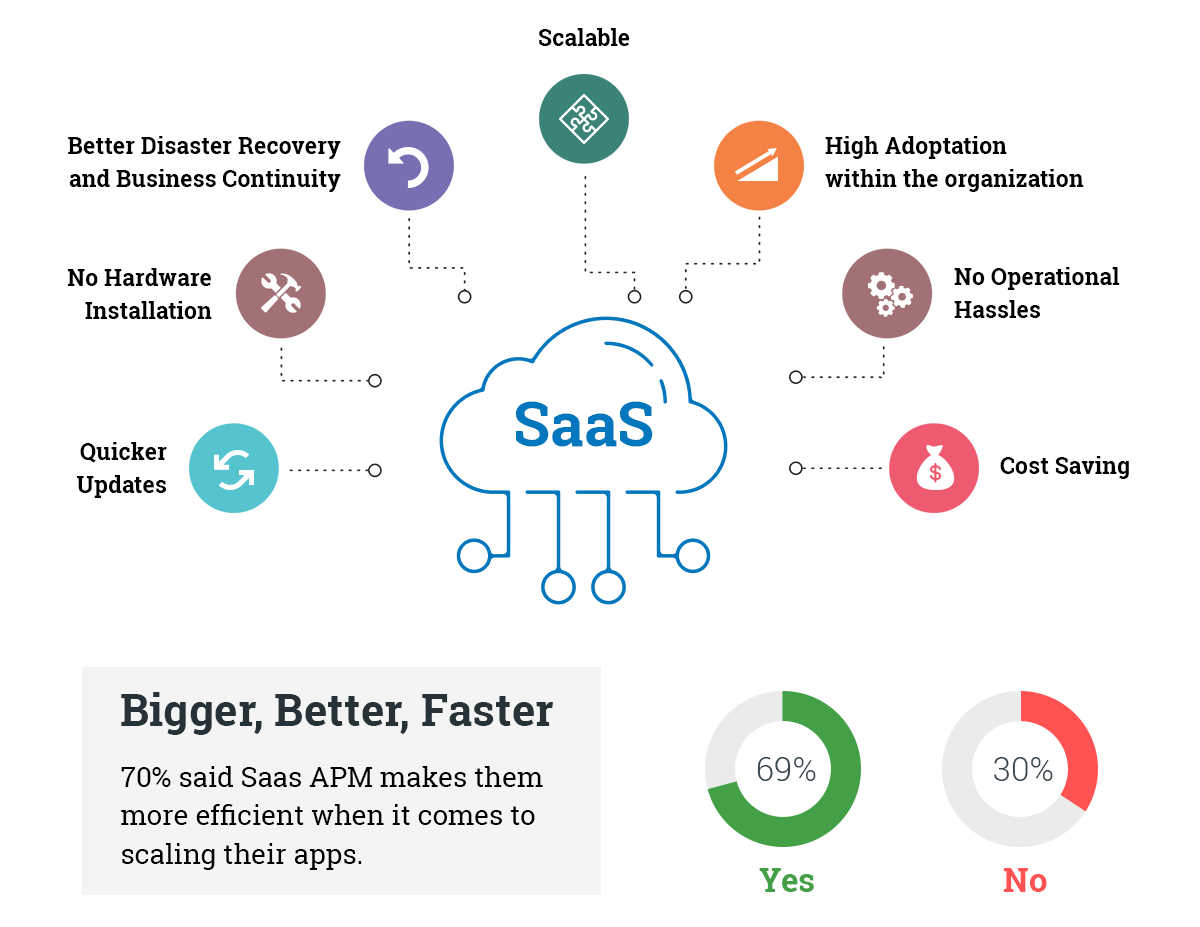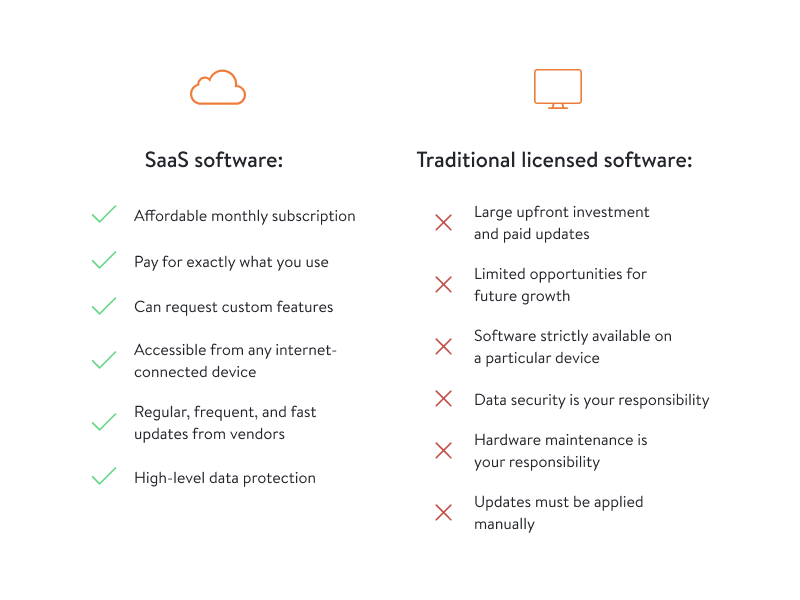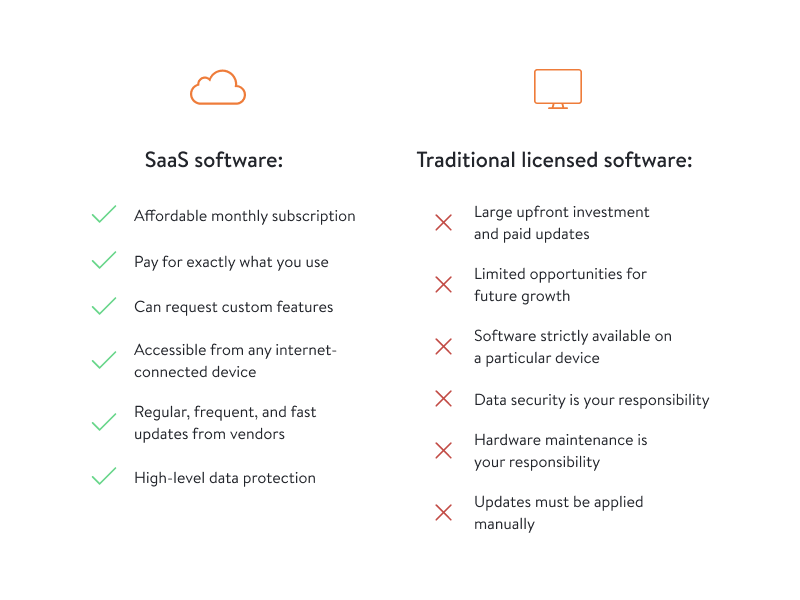
What is a Saas Application?
A SaaS application is a software delivery model where the application is hosted on a cloud-based server and delivered to users over the internet. The service provider hosts the infrastructure, manages security, and provides updates and maintenance. Users access these applications through web browsers or mobile devices without having to install anything locally.
SaaS solutions come in different types such as Customer Relationship Management (CRM), Human Resources (HR), Enterprise Resource Planning (ERP), Marketing Automation, etc. Each type of SaaS app caters to specific business needs and requirements.
One benefit of using SaaS apps is that they are highly scalable with an ability to handle high traffic volumes without any performance issues. With this approach, you only pay for what you need and can easily add more capacity as your business grows.
Another advantage of using SaaS apps is cost-effectiveness since there's no upfront hardware or software investment required unlike traditional models. Additionally, Saas developers often offer subscription plans giving businesses flexibility in their budgeting.
Saas application development offers several benefits making it perfect for businesses looking for an efficient solution that scales with their growth while being cost-effective at the same time.

The Different Types of Saas Applications
SaaS apps come in various forms, each serving a different purpose. Here are the different types of SaaS development services that businesses can choose from:
1. Communication and Collaboration Tools: These tools help teams communicate and work together virtually. Examples include Slack, Microsoft Teams, and Zoom.
2. Customer Relationship Management (CRM) Software: CRM software helps companies manage their interactions with customers throughout the entire customer lifecycle, from acquiring new leads to managing existing accounts. Examples include Salesforce and HubSpot.
3. Human Resource Management Systems (HRMS): HRMS handles tasks related to employee management such as payroll processing, benefits administration, onboarding/offboarding employees etc.. Examples include BambooHR and Gusto.
4. Accounting Software: This software automates accounting processes such as invoicing, billing payments etc.. Some popular examples of accounting software are Quickbooks Online or Xero.
5. Marketing Automation Platforms: These platforms automate marketing campaigns by integrating email campaigns social media outreach ads optimization etc... Popular options here include Marketo or Pardot.
There is no one-size-fits-all approach when it comes to choosing a Saas application for your business needs - it's important to assess which type suits your business goals best!

How difficult is it to build a SaaS?
Building a Software as a Service (SaaS) product can be a complex and challenging endeavor, but the difficulty level can vary depending on several factors. Here are some considerations:
- Technical Complexity: The technical complexity of building a SaaS product can vary depending on the scope and functionality of the application. Developing a basic SaaS product with standard features may be relatively straightforward, but as the complexity increases, challenges can arise in areas such as scalability, data management, security, integrations, and performance optimization. The more complex the product requirements, the higher the technical difficulty.
- Team Expertise: The expertise and experience of your development team play a significant role in the difficulty of building a SaaS solution. If your team has prior experience in saas solution applications or possesses the necessary skills in areas like web development, cloud based saas application, security, and database management, it can help mitigate challenges. However, if your team lacks experience in specific areas, it may require additional time and effort to acquire the necessary expertise or involve external specialists.
- Infrastructure and Technologies: Building a SaaS architecture typically involves leveraging various technologies, frameworks, and tools, which can add to the complexity. Integrating with third-party services, managing server infrastructure, implementing cloud based saas application, and ensuring data privacy and security all contribute to the overall difficulty. Staying up-to-date with the latest technology trends and selecting the right tools for your specific requirements is crucial.
- Time and Resources: Developing a SaaS product requires sufficient time, resources, and planning. It involves multiple stages, including conceptualization, design, development, testing, deployment, and ongoing maintenance. Adequate resource allocation, project management, and effective coordination among team members are essential to ensure a smooth development process.
- Market and Competition: The difficulty level can also be influenced by market dynamics and competition. If you're entering a highly competitive market with established players, it may require additional effort to differentiate your product and meet customer expectations. Conducting thorough market research, understanding user needs, and identifying unique selling points can help address these challenges.
It's important to note that while building a SaaS project can be challenging, it is also an exciting opportunity for innovation and growth. Breaking down the development process into manageable stages, leveraging appropriate technologies, seeking expert guidance when needed, and having a dedicated and skilled team can help overcome the difficulties associated with building a SaaS product.
What are the steps in developing a SaaS?
Developing a Software as a Service (SaaS) involves several steps to create a scalable and reliable product. Here are the general steps involved in developing a SaaS:
- Idea Generation: Identify a problem or a market need that your saas app will address. Conduct market research to validate the demand and identify your target audience.
- Conceptualization and Planning: Define your SaaS product's features, functionalities, and overall scope. Create a roadmap and develop a clear plan for development, deployment, and ongoing maintenance.
- Architecture and Design: Design the technical architecture of your SaaS application, including database structure, user interface (UI), and user experience (UX) design. Consider scalability, security, and performance requirements during this phase.
- Development: Implement the SaaS application based on the architecture and design. This involves coding, integrating necessary APIs and third-party services, and building the necessary infrastructure. Consider using an agile development methodology for flexibility and iterative improvements.
- Testing and Quality Assurance: Conduct rigorous testing of your SaaS product to identify and fix any bugs, errors, or usability issues. Perform functional testing, performance testing, security testing, and user acceptance testing to ensure a robust and reliable system.
- Deployment and Infrastructure: Set up the necessary infrastructure to host and deliver your SaaS application. This includes cloud hosting, configuring servers, databases, and other components required for your product to operate efficiently.
- Security and Compliance: Implement appropriate security measures to protect user data and ensure compliance with relevant data protection regulations. Encrypt sensitive information, establish secure authentication methods, and regularly update security patches.
- Monitoring and Analytics: Set up monitoring tools to track the performance, availability, and user behavior of your SaaS product. This allows you to identify and address any performance or usability issues, and make data-driven decisions for future improvements.
- Customer Support and Documentation: Develop comprehensive documentation and provide customer support channels to assist users in using your SaaS product effectively. Create user guides, FAQs, tutorials, and consider implementing a ticketing system or live chat support.
- Continuous Improvement: Gather user feedback and analyze usage patterns to identify areas of improvement. Iterate and enhance your SaaS product based on user needs and changing market dynamics. Regularly release updates and new features to add value and retain customers.

What is SaaS platform development?
SaaS platform development refers to the process of creating a Software as a Service (SaaS) platform that enables the delivery of software applications over the internet to end-users as a subscription-based service. A SaaS platform serves as the foundation for hosting, managing, and a software distribution model for delivering multiple software applications to customers.Here are some key aspects of SaaS platform development:
- Infrastructure and Hosting: Developing a SaaS platform involves setting up the necessary infrastructure, such as servers, databases, and networking components, to host and deliver the software applications. Cloud computing platforms like Amazon Web Services (AWS), Microsoft Azure, or Google Cloud Platform (GCP) are commonly used for scalable and cost-effective hosting.
- Multi-Tenancy Architecture: SaaS app are designed to support multiple customers (tenants) who access and use the software applications. The platform should have a multi-tenancy architecture that enables efficient resource sharing, data isolation, and customization options for each tenant.
- User Management and Authentication: A SaaS platform typically includes user management functionalities to handle user registration, authentication, and authorization. This allows administrators to manage user accounts, access levels, and permissions across different software applications within the platform.
- Application Lifecycle Management: The SaaS platform should provide tools and features for application lifecycle management, including application deployment, version control, updates, and monitoring. This ensures smooth operation and facilitates the release of new features or bug fixes to the software applications.
- Billing and Subscription Management: SaaS platforms often include billing and subscription management capabilities to handle the financial aspects of the service. This may involve managing subscription plans, invoicing, payment processing, and handling recurring billing cycles.
- API and Integration Support: SaaS platforms typically expose APIs (Application Programming Interfaces) that allow developers to integrate third-party services, build custom extensions, or enable interoperability with other systems. Providing comprehensive API documentation and developer tools is crucial for encouraging integrations and extending the platform's capabilities.
- Analytics and Reporting: SaaS platforms often include analytics and reporting features to provide insights into usage patterns, performance metrics, and user behavior. These analytics can help administrators and application owners make data-driven decisions, identify areas for improvement, and track the success of their software applications.
- Security and Compliance: Security is a critical aspect of saas development company. Implementing robust security measures, such as encryption, access controls, secure APIs, and regular security audits, helps protect user data and ensure compliance with relevant data protection regulations.
- Scalability and Performance: SaaS platforms need to be designed for scalability to handle increasing user demands and application workloads. This may involve employing techniques like load balancing, auto-scaling, caching, and database optimization to ensure high performance and responsiveness.
- Ongoing Maintenance and Support: After the initial development, a SaaS platform requires ongoing maintenance, bug fixing, and feature enhancements. Providing customer support channels and promptly addressing user feedback or issues is essential for maintaining customer satisfaction and retention.
SaaS platform development involves combining all these elements into a cohesive and reliable platform that enables the successful delivery of software applications as a service. The specific requirements and features of the platform will depend on the target market, intended software applications, and the unique needs of the customers and tenants.

What programming language to build SaaS?
There isn't a single "best" programming language for building a saas app as the choice of programming language depends on various factors such as the specific requirements of your saas product development side, your team's expertise, the scalability needed, and the ecosystem surrounding the language. However, here are some popular programming languages commonly used for developing saas application development services:- Python: Python is a versatile and widely-used programming language known for its simplicity and readability. It has a large number of frameworks and libraries that facilitate rapid development, such as Django and Flask. Python is often preferred for its focus on developer productivity.
- JavaScript: JavaScript is a fundamental language for web development. It is commonly used for building interactive user interfaces and handling client-side logic. Popular frameworks like React, Angular, and Vue.js are often used for building robust front-end components of SaaS applications.
- Ruby: Ruby is known for its elegant syntax and developer-friendly environment. The Ruby on Rails framework is frequently used to build web applications quickly, making it suitable for creating saas solutions with time-to-market considerations.
- Java: Java is a robust and widely adopted programming language. It offers strong enterprise capabilities and a vast ecosystem of frameworks and libraries. Java is often chosen for large-scale and complex SaaS applications that require high performance and reliability.
- PHP: PHP is a popular language for web development and is widely supported by web hosting providers. It has a range of frameworks such as Laravel and Symfony that simplify the development process and enable rapid prototyping.
- Go: Go (or Golang) is a statically-typed language known for its simplicity, performance, and built-in support for concurrency. It is well-suited for developing scalable and high-performance SaaS applications, particularly in the backend or microservices architecture.

How do I become a SaaS developer?
Becoming a SaaS developer typically involves a combination of education, acquiring relevant skills, practical experience, and staying up-to-date with the latest industry trends. Here are some steps to help you embark on the path of becoming a SaaS developer:- Education and Foundation: Start by obtaining a solid foundation in computer science or software engineering. Consider pursuing a degree in computer science, software engineering, or a related field. This formal education will provide you with fundamental knowledge of programming concepts, algorithms, data structures, and software development principles.
- Learn Programming Languages: Familiarize yourself with programming languages commonly used in SaaS development, such as Python, JavaScript, Ruby, Java, or PHP. Start by mastering one or two languages that align with your goals and the prevalent languages in the industry.
- Web Development: Gain proficiency in web development technologies and frameworks. SaaS products are typically built using web technologies such as HTML, CSS, and JavaScript. Familiarize yourself with front-end frameworks like React, Angular, or Vue.js, as well as back-end frameworks like Django, Ruby on Rails, Laravel, or Node.js.
- Cloud databases and Infrastructure: Acquire knowledge of cloud computing platforms like Amazon Web Services (AWS), Microsoft Azure, or Google Cloud Platform (GCP). Understand concepts such as virtualization, containerization (e.g., Docker), and deployment strategies to effectively manage and scale SaaS applications.
- Database Management: Learn about database management systems (DBMS) and database design concepts. Gain proficiency in SQL (Structured Query Language) and understand database models, normalization, and data storage techniques.
- API Integration: SaaS products often integrate with external services or APIs. Familiarize yourself with RESTful API principles, authentication methods, and how to interact with APIs to exchange data between systems.
- Security and Data Privacy: Develop an understanding of security best practices and data privacy considerations in SaaS development. Learn about encryption, authentication mechanisms, and securing user data to ensure compliance with relevant regulations.
- Continuous Learning: SaaS development is a rapidly evolving field. Stay updated with the latest trends, frameworks, and technologies by exploring industry blogs, attending webinars, joining relevant communities, and participating in online courses or bootcamps.
- Gain Practical Experience: Apply your knowledge by working on practical projects. Consider building your own SaaS applications, contributing to open-source projects, or collaborating on team projects to gain hands-on experience and showcase your skills.
- Networking and Collaboration: Engage with the developer community, attend industry events, join relevant forums, and participate in hackathons or coding competitions. Networking with like-minded individuals can provide valuable insights, opportunities for collaboration, and mentorship.
The Benefits of a Saas Application
A Saas application is a software solution that is hosted by the service provider and accessed through the internet. It has numerous benefits for businesses of all sizes, especially when compared to traditional on-premise solutions.
One of the main advantages of using a Saas application is its subscription-based model. Instead of paying upfront costs for hardware, software licenses, and installation fees, businesses can pay a monthly or annual fee based on their usage.
Another benefit is scalability. With an on-premise solution, adding new users or expanding functionality can be time-consuming and expensive. However, with a Saas application, businesses can easily scale up or down depending on their needs without any additional infrastructure investment.
Saas applications also offer greater accessibility since they are accessible from anywhere with an internet connection. This provides flexibility for remote workers who need access to critical business data while working outside the office environment.
Because updates and upgrades are managed by the service provider, organizations don't have to worry about maintaining outdated systems or ensuring compatibility across different devices.
Choosing to develop a Saas application for your business means lower upfront costs and increased flexibility in terms of both functionality and accessibility – making it an attractive choice for many modern-day companies looking to stay competitive in today's fast-paced world.

Is Amazon a SaaS company?
While Amazon offers various services and products, it is not primarily considered a Software as a Service (SaaS) company. Amazon is a multinational conglomerate that operates in several sectors, including e-commerce, cloud provider, digital streaming, artificial intelligence, and more. However, within its range of services, Amazon does provide certain SaaS offerings through its cloud computing division called Amazon Web Services (AWS).
AWS offers a broad range of cloud services, including infrastructure as a service (IaaS), platform as a service (PaaS), and software as a service (SaaS). AWS provides SaaS products like Amazon WorkSpaces (virtual desktops), Amazon Chime (communication and collaboration tools), Amazon Connect (contact center solutions), and many others. These SaaS offerings allow customers to leverage Amazon's cloud infrastructure and access software applications as a subscription-based service.
While AWS offers a comprehensive suite of cloud services, it's essential to consider competitors of GitHub in the market. These competitors provide similar or alternative solutions for code hosting, version control, and collaboration.Nevertheless, Amazon's primary revenue streams come from its e-commerce platform, retail operations, and other business segments. While AWS is a significant part of Amazon's business and offers SaaS products, Amazon as a whole is not typically categorized as a pure SaaS company.
The Challenges of Developing a Saas Application
Developing a SaaS application can be both rewarding and challenging. One of the biggest challenges is ensuring that your application meets the needs of your target audience. This requires extensive research, planning, and development.
Another challenge is scalability. As your user base grows, so does the demand on your infrastructure. You need to ensure that you have enough resources to handle increased traffic without sacrificing performance or reliability.
Security is also a major concern when developing a SaaS application. You need to protect user data from unauthorized access while making sure that only authorized users can access it.
Maintaining compatibility with different devices and operating systems can also be a challenge. Your application should function seamlessly across all platforms for maximum accessibility.
Keeping up with evolving technologies and changing market trends poses yet another challenge in developing SaaS applications. It's important to stay informed about emerging technologies and incorporate them into your product roadmap as needed.
Developing a successful SaaS application requires careful consideration of these challenges along with proactive measures to overcome them effectively.
Solutions to the Challenges of Developing a Saas Application
Developing a SaaS application can be challenging, but there are solutions to overcome these challenges. One of the main issues is ensuring that the application is scalable and can handle large numbers of users. This challenge can be addressed by using cloud-based hosting platforms such as AWS or Azure.
Another common issue when developing a SaaS application is data security. To ensure data protection, developers should implement comprehensive security measures such as encryption and access control mechanisms. It's also important to conduct regular security audits to identify potential vulnerabilities.
Application performance and speed are also critical for delivering an excellent user experience. Developers should optimize the software architecture and use caching technologies to improve response times.
Maintaining code quality and managing updates can also pose challenges during development. Using agile methodologies like Scrum or Kanban, combined with automated testing tools, can help manage code changes effectively while maintaining high-quality standards.
Providing exceptional customer support is essential for any successful SaaS product. Developers should provide self-service options like documentation or FAQ sections while offering responsive customer support channels like email or chatbots.
By addressing these challenges head-on with practical solutions, developers will create robust applications that deliver value for customers while driving business growth opportunities

Conclusion
Developing a Saas application presents both challenges and benefits for businesses. The various types of Saas applications provide versatile options to suit different business needs. The benefits of Saas applications are numerous, including cost-effectiveness, accessibility, and scalability.
However, the development process can be challenging due to issues such as security concerns and integration with existing systems. Fortunately, there are solutions available that address these challenges effectively.
By partnering with reliable Saas development companies or hiring skilled developers in-house, businesses can overcome these hurdles while enjoying the many advantages of Saas technology.
Investing in Saas software and application development is an excellent way for businesses to remain competitive in today's fast-paced digital landscape. With careful planning and execution using best practices in design and implementation from experienced professionals or experts alike will ensure success by delivering high-quality products that meet users' expectations while maximizing ROI.
